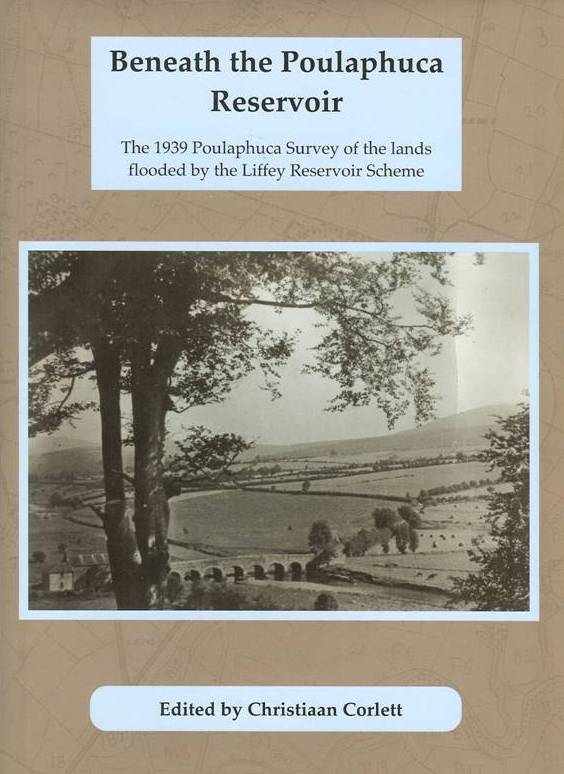 Irish Eyes
Irish Eyes
By
Mattie Lennon
Reservoirs of History
“Now that the reservoir dam at Poulaphuca has been completed, flood is rising to the last ridge below Valleymount and another sky has tumbled into the heather. The narrow lands from which my father’s people came have vanished under water and the trout are too heavy to jump”. (Poet, Austin Clarke)
I have often referred to the beauty of Poulaphuca Lake on the shores of which I was reared. To the tourist or casual visitor it looks like a natural lake which has been there for millennia but it is man-made and has an interesting history. In the late “thirties” a thriving farming community was removed from their homesteads in preparation for the flooding in 1940.
The lifestyle, legends, folklore and mythology of that community would, probably, have been lost to posterity but for a small group of dedicated people who (hurridly) carried out “The Poulaphuca Survey”.
However the contents of this analysis were known to only a handful of people until now.
It has been compiled and edited by Christiaan Corlett in a 352 page A4 hardback book titled, “Beneath the Poulaphuca Reservoir”.
In the Preface, Aidan O’ Sullivan, who was born and reared in Valleymount says, “. . .the Poulaphuca Survey was . . .a hidden thing until now, submerged from view in scholarly archives and photographic collections and certainly not known to local people”
When I asked Mr. Corlett what prompted him to take on the task he told me,
“I suppose the inspiration came out of the Liam Price Notebooks which I published in 2002, and which mentioned very little about the so-called Poulaphuca Survey. Yet, while researching the Notebooks and Liam Price himself I had seen a little album of photographs, complete with extended captions and text by Katherine Price (Liam Price's sister). This album is held in the Placenames Branch of the Department of Community, Rural and Gaeltacht Affairs. Once the Price Notebooks were published I planned to revisit this album, and thought it might make a nice stand alone article, but that soon changed after I contacted Fred Aalen who showed me a box full of notes, photos and sketches that Liam Price had given him in the early 1960s. This box contained most of the material belonged to the so-called Poulaphuca Survey of 1939. That's when it took off into a book.”
The book includes more than 300 photographs of happy families and farm houses in a variety of styles as well as sketches of settle-beds, fireplaces and farm implements with strange, and sometimes bi-lingual names.
Christiaan Corlett has captured everything from TDs’ ranting to journalists’ predictions. From folk tales and legends (of this world and the next) to scientific data and geographical detail. Local people describe, in colourful language, what they are about to leave behind, such as, “ . . . turf-cutters . . like white butterflies on a brown bog in the sunshine”. In Dail Eireann Deputy Thomas Kelly claimed, “I do not think that the doleful tales which the Deputies from Wicklow have put before the House today are necessary . . . They will get ample compensation , sufficient to recompense them for even any sentimental values attached to their old homes”. Gertrude Gaffney in the Irish Independent predicted that, “Boats with coloured sails and dipping oars will be skimming over its calm surface.”
"BENEATH THE POULAPHUCA RESERVOIR"
is available (price €35) from,
Government Publications Office, Sun Alliance House,
Molesworth Street, Dublin 2.
See Cover pic at bottom of page.
BUSES, TRAINS AND GAELIC GAMES
“Buses, Trains and Gaelic Games” is a history of Gaelic games in Irish transport from 1885 to the present day. The author, John Cassidy, traces the path of Gaelic football, hurling, handball and camogie teams from the days of Charles Bianconi (the father of public trans[port, in Ireland) to the twenty-first century.
Since the foundation of Coras Iompar Eireann (CIE) in 1945 every section of the company, urban and rural, contributed to Gaelic sports and provided players at county, national and international level.
In his foreword, CIE Chairman John J. Lynch, says, “I deem it a high honour and privilege to be invited to contribute a FOREWARD to the history of the many CIE G.A.A. clubs nationwide.”
He goes on to laud “ the great sporting bodies within the CIE family ” and refers to the fact that their achievements “ both on and off the field, testify to the dedication of so many people . . . , which stands as a testimony to the organisational skills and tremendous sense of purpose which CIE has harnessed throughout its existence. Running a sporting organisation is a time consuming business but with the continued voluntary involvement of managers, coaches, administrators, players and supporters CIE will pass on a substantial legacy for future generations to build upon.”
Through research, dedication and literary skill the author has given us a comprehensive and colourful account of clubs, teams and individual players associated with Irish transport over the generations. Some of these didn’t get the coverage they deserved , from the media, during their careers. One such, who features in this publication, was the most decorated player in the history of Gaelic games. Camogie player Kathleen Mills made her debut with the Great Southern Railway Club, Dublin, in 1938.
In 1941 she played for Dublin, when they were beaten by Cork, in the All-Ireland final. She was on the winning Dublin team which beat Cork in 1942 and 1943. She went on to win all-Ireland medals in 1948, 1950, 1951, 1952, 1953, 1954 and 1955. She was Captain when Dublin beat Tipperary 1n 1957.
More All-Ireland medals were to follow in 1959, 1960 and 1961. The 1961 final was on her 38th birthday and it was the last time she wore the Dublin jersey. In retirement she was known as “the Christy Ring of the camogie world”. She died in august 1996.
“Buses, Trains and Gaelic Games”
is available from
John Cassidy who can be contacted at:
johncassidy92@yahoo.com
Click on author's byline for bio and list of other works published by Pencil Stubs Online.

|